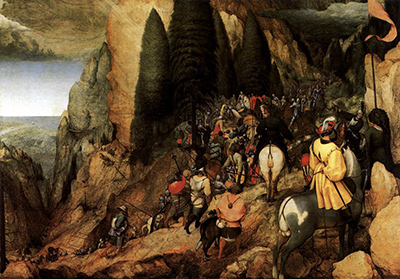The Conversion of Paul was painted by Pieter Breugel the Elder in Antwerp in 1567
Oil on panel, it is currently exhibited at the Kunsthistoriches Museum in Vienna.
At the time, Europe was in conflict between the Protestant Reformation and the counter Catholic Reformation with widespread persecution on both sides.
The Protestants engaged in widespread destruction of art and the Catholic Church responded to this iconaclasm in 1563 by deciding that religious art should be more religious in content, focusing less on materialism and decoration.
In this atmosphere, Breugel created the piece, illustrating the biblical account, but also commenting on contemporary events.
The subject is Paul - a persecutor of the early christian movement - experiencing a revelation on the road to Damascus that led him to embrace Jesus Christ as the messiah.
The painter depicts Paul and the soldiers that accompany him in 16th century attire and carrying contemporary weaponry to suggest the relevance of the story to his own time.
It has been suggested that the setting of the scene on a pine-clad mountain is a direct reference to the 1567 crossing of the alps by the 3rd Duke of Alba with an army of 10,000 men on their way to suppress Dutch revolts.
Other critics have pointed to a 1509 engraving by Lucas van Leyden, one of the first exponents of genre painting.
Compositionally the painter utilises the mannerist device of placing the principle characters in the middle-distance - surrounded by incidental figures - with the intention of engaging the spectator in a search for Paul. He used this technique in other works such as The Procession to Calvary.
This work was purchased in 1594 by Archduke Ernest of Austria, later passing into the collections of the Holy Roman Emperor, Rudolf the Second.




